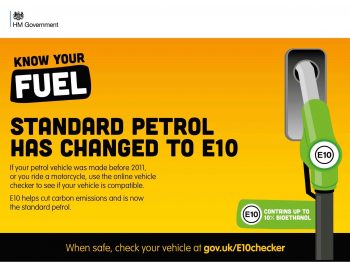Drivers in the dark as E10 becomes standard grade of petrol
The new E10 petrol has now arrived in UK forecourts, but concerns remain over how much drivers are aware of the move.

Despite a government awareness campaign run this summer, research indicates one in four drivers (24%) are unaware that the new fuel is being introduced
The greener fuel has become the standard grade of petrol at UK pumps from 1 September, helping to cut transport CO2 emissions; it’s forecast to cut CO2 by 750,00 tonnes a year – equivalent to taking up to 350,000 cars off the road. This is thanks to the higher 10% blend of bioethanol used in E10, which is up from the current 5% limit in E5 and key to its eco-friendlier credentials.
Transport Secretary Grant Shapps explained: “Every journey matters as we drive forward the green industrial revolution, which is why the rollout of E10 is so important. It’ll help us cut road greenhouse gas emissions and meet our ambitious net zero targets.
“Although more and more drivers are switching to electric, there are steps we can take today to reduce emissions from the millions of vehicles already on our roads – the small switch to E10 petrol will reduce greenhouse gas emissions as we accelerate towards a greener transport future.”
There are some downsides though. While every new petrol car sold since 1 January 2011 has been required to be fully warranted to use E10 – which means fleet cars won’t be affected –older vehicles, including classic cars and some from the early 2000s, won’t be compatible with the new fuel. It’s estimated that some 600,000 cars will be affected.
And despite a government awareness campaign run this summer, research indicates one in four drivers (24%) are unaware that the new fuel is being introduced while more than a quarter of drivers (27%) are yet to check whether their car is compatible it, according to new RAC research has found.
Those with incompatible vehicles will have to seek out and pay for more expensive, E5 super unleaded if they wish to keep them running.
RAC head of policy Nicholas Lyes said: “While the vast majority of drivers of petrol cars aren’t affected, a sizeable minority will be and the only way to be sure is to use the official online checker. Those that discover their cars aren’t compatible will unfortunately need to seek out and pay for a hefty premium for E5 super unleaded fuel instead. The cost of doing this could quickly add up for people who need to use their cars regularly, something our research shows all too plainly. Drivers who will continue to rely on E5 will also need to make sure the filling station their visiting stocks the fuel in the first place, or risk running out of fuel and having to call on their breakdown provider.”
Overall, the move to E10 petrol is expected to bring positive eco benefits – providing the ethanol in the E10 fuel is actually biofuel, according to Jun Peng, visiting Professor of Sustainable Engineering at the University of Bedfordshire.
“We have to be realistic about the impact of this measure. Moving from E5 to E10 petrol will not reduce a car’s carbon emissions, across its life cycle, by any more than 3%. Nevertheless, the shift is an easy way to reduce CO2 emissions for road vehicles.
“We have to hope that the ethanol being added to make the E10 actually does come from biofuel though. It is possible to make ethanol from reformed fossil fuels. If we use this we’ll actually be increasing CO2 emissions by making the switch to E10.”
He continued: “Overall it is a very sensible measure. We shouldn’t exaggerate the drawbacks but neither should we comfort ourselves that this will make a great deal of difference to our CO2 emissions targets.”

















